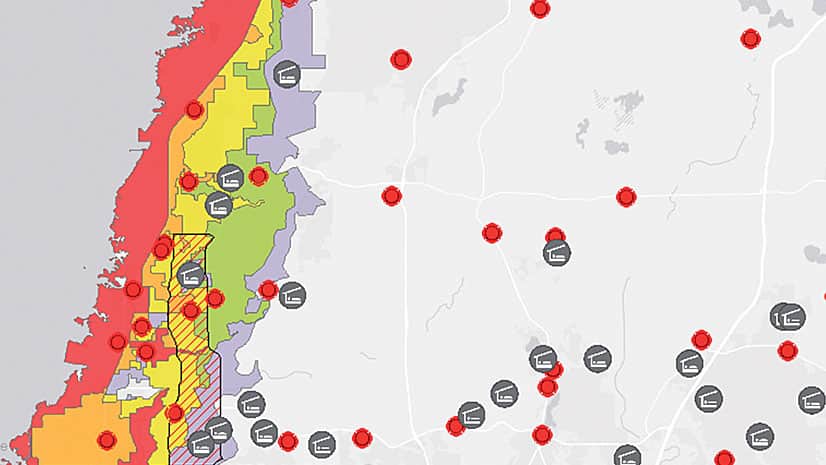After years of gestation, Congress passed the comprehensive Geospatial Data Act (GDA) of 2018 into law on October 5, 2018. While the GDA primarily addresses geospatial data management and coordination for federal agencies, it will also have far-reaching implications and benefits for the broader GIS user community.
Those of us in the GIS research and user communities have long recognized the need to better organize and manage geospatial data among federal agencies, the federal government, local and state authorities, the private sector, and academia. The GDA contains provisions to improve the extent and efficiency of that coordination. The bill codifies and expands the role of the Federal Geographic Data Committee (FGDC) and formally supports the goal of creating a robust National Spatial Data Infrastructure (NSDI), which is defined in the new law as “the technology, policies, criteria, standards, and employees necessary to promote geospatial data sharing throughout the Federal Government, State, tribal, and local governments, and the private sector (including nonprofit organizations and institutions of higher education).”
Significantly, the GDA also requires all federal agencies responsible for geospatial data to conduct an annual inventory and assessment of their geospatial data assets. This process should generate substantial new data collection and upgrading and stimulate more forward thinking about the long-term value of GIS in government operations. Additionally, the GDA provides a mandate and support for the FGDC to operate “an electronic service that provides access to geospatial data and metadata”—known as the GeoPlatform—for GIS users and the general public.
Geographic and GIS literacy and spatial thinking are universal skills. If you learn this technology, it doesn’t pigeonhole you into one career.
The implementation of the GDA during the next few years will need to rely on the services and tools from our world-leading network of GIS and IT mapping communities and companies, which are already powering sustained growth in new technologies and US jobs. As our vibrant GIS community continues to expand, it has further raised awareness and recognition by Congress of the importance of GIS as a crucial tool for US infrastructure development and the defense and security of our nation, as well as a management tool for governments and major businesses throughout the world.
More Good News: No Exclusionary Procurement Provisions
For the broader GIS user community, what is not in the GDA may be even more important than what is. The earlier version of the Geospatial Data Act of 2017 (S.1253) contained language that would have imposed a system of exclusionary procurement that would have thwarted competition and innovation. It would have prevented most companies and GIS organizations in the dynamic and rapidly growing GIS and mapping sector from receiving federal contracts for mapping or GIS activities, including GPS field data collection, GIS analysis, Internet mapping, location-based services, remote sensing, and digital or manual mapmaking of almost any type.
I am pleased to point out that the GDA of 2018 was passed without the damaging exclusionary procurement provisions that were previously in the bill. After considering input from a variety of stakeholders, House and Senate congressional committees finally settled on a streamlined GDA bill stripped of the language that would have limited federal procurement of geospatial data and services to a small segment of the geospatial community. The Association of American Geographers (AAG) is proud to have taken the lead on helping to create a balanced approach for the GDA, resulting in a bill that is inclusive of the broader geography and geospatial communities.
AAG has been monitoring and providing expertise regarding the GDA for many years at the request of congressional members. We thank the bipartisan efforts of the bill’s cosponsors, Senators Orrin Hatch (R-UT) and Mark Warner (D-VA) and Congressmen Bruce Westerman (R-AR) and Seth Moulton (D-MA), for the opportunity to work together to shape and pass an excellent Geospatial Data Act. This legislation will save US taxpayers millions of dollars, as it allows government agencies to better coordinate with one another to prevent duplication and acquire geospatial expertise, technology, services, and data from across the full range of a dynamic and flourishing US geographic and geospatial community.
Implementing the GDA with Help from a Well-Rounded Workforce
The implementation of the GDA will require not only continued research and development of new GIS and related geospatial technologies but also a well-rounded geography and GIS workforce. Education has always been a key component of our geospatial ecosystem, and the AAG’s 12,000 members play a key role in educating the next generation of geographers, GIScientists, geoscience researchers, and GIS users.
As GDA cosponsor Congressman Westerman stressed in a GIS Day speech shortly after the GDA passed, “Education and understanding geospatial data is an increasingly important skill in today’s world because it’s widely used every day.” AAG’s Candice Luebbering, speaking at the same event, added, “Geographic and GIS literacy and spatial thinking are universal skills. If you learn this technology, it doesn’t pigeonhole you into one career.”
We look forward to supporting the implementation of the GDA in the future—in partnership with you, the GIS user community.
Contact Doug Richardson at drichardson@aag.org.


